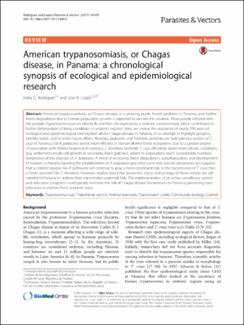American trypanosomiasis, or Chagas disease, in Panama: a chronological synopsis of ecological and epidemiological research
Fecha
2017-10-10Autor
Rodriguez, Indra G.
Loaiza, Jose R.
Metadatos
Mostrar el registro completo del ítemResumen
American trypanosomiasis, or Chagas disease, is a growing public health problem in Panama, and further forest degradation due to human population growth is expected to worsen the situation. Most people infected with the parasite Trypanosoma cruzi are silently ill, and their life expectancy is severely compromised, which contributes to further deterioration of living conditions in endemic regions. Here, we review the outcomes of nearly 100 years of ecological and epidemiological investigation about Chagas disease in Panama, in an attempt to highlight progress, identify needs, and re-orient future efforts. Rhodnius pallescens and Triatoma dimidiata are both primary vectors of T. cruzi in Panama, but R. pallescens seems more efficient in human-altered forest ecosystems due to a greater degree of association with Attalea butyracea. In contrast, T. dimidiata transmits T. cruzi efficiently under more sylvatic conditions (e.g. settlements inside old-growth or secondary forest patches), where its populations reach considerable numbers irrespective of the absence of A. butyracea. A trend of increasing forest degradation, suburbanization, and development of tourism in Panama favoring the establishment of A. butyracea and other palm tree species (Acrocomia sp.) suggests that a colonist species like R. pallescens will continue to play a more prominent role in the transmission of T. cruzi than a forest specialist like T. dimidiata. However, studies about the taxonomic status and ecology of these vectors are still needed in Panama to address their transmission potential fully. The implementation of an active surveillance system and education programs could greatly minimize the risk of Chagas disease transmission in Panama, preventing fatal infections in children from endemic areas

